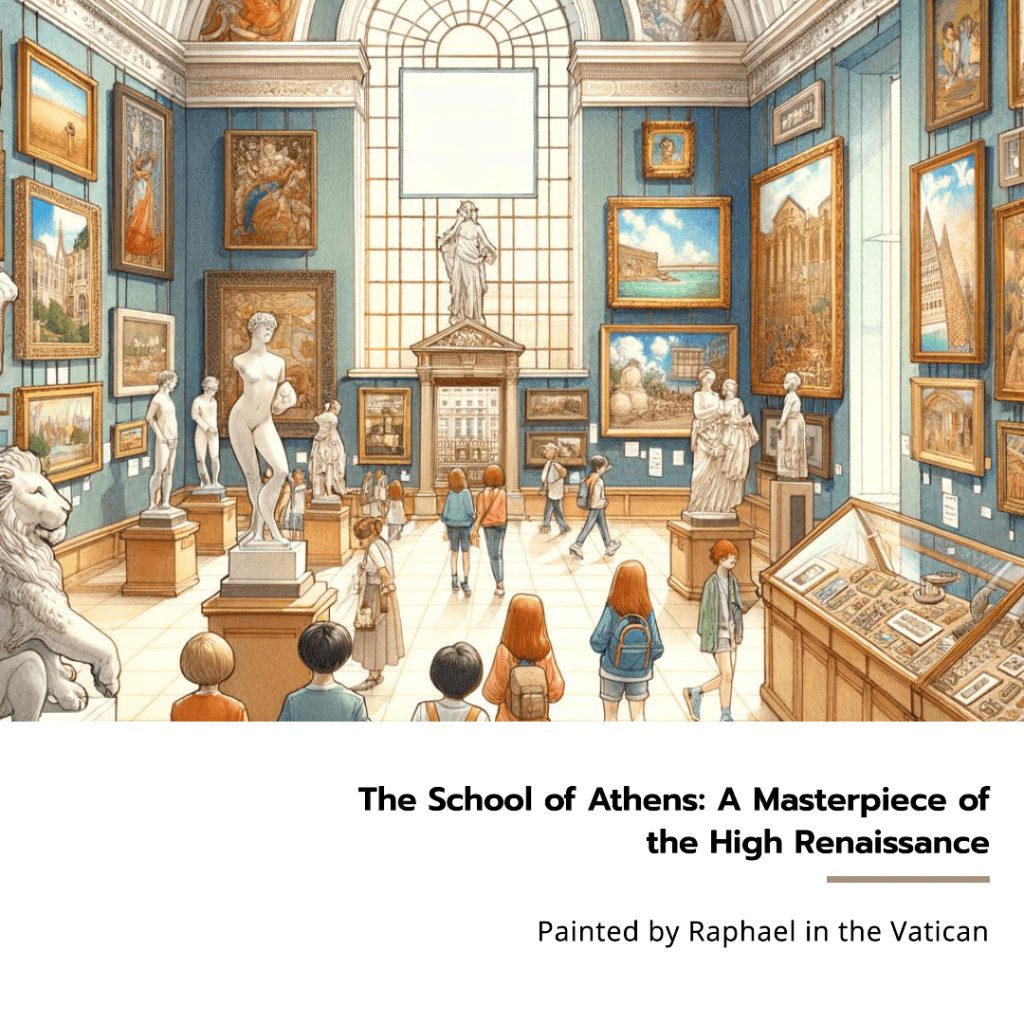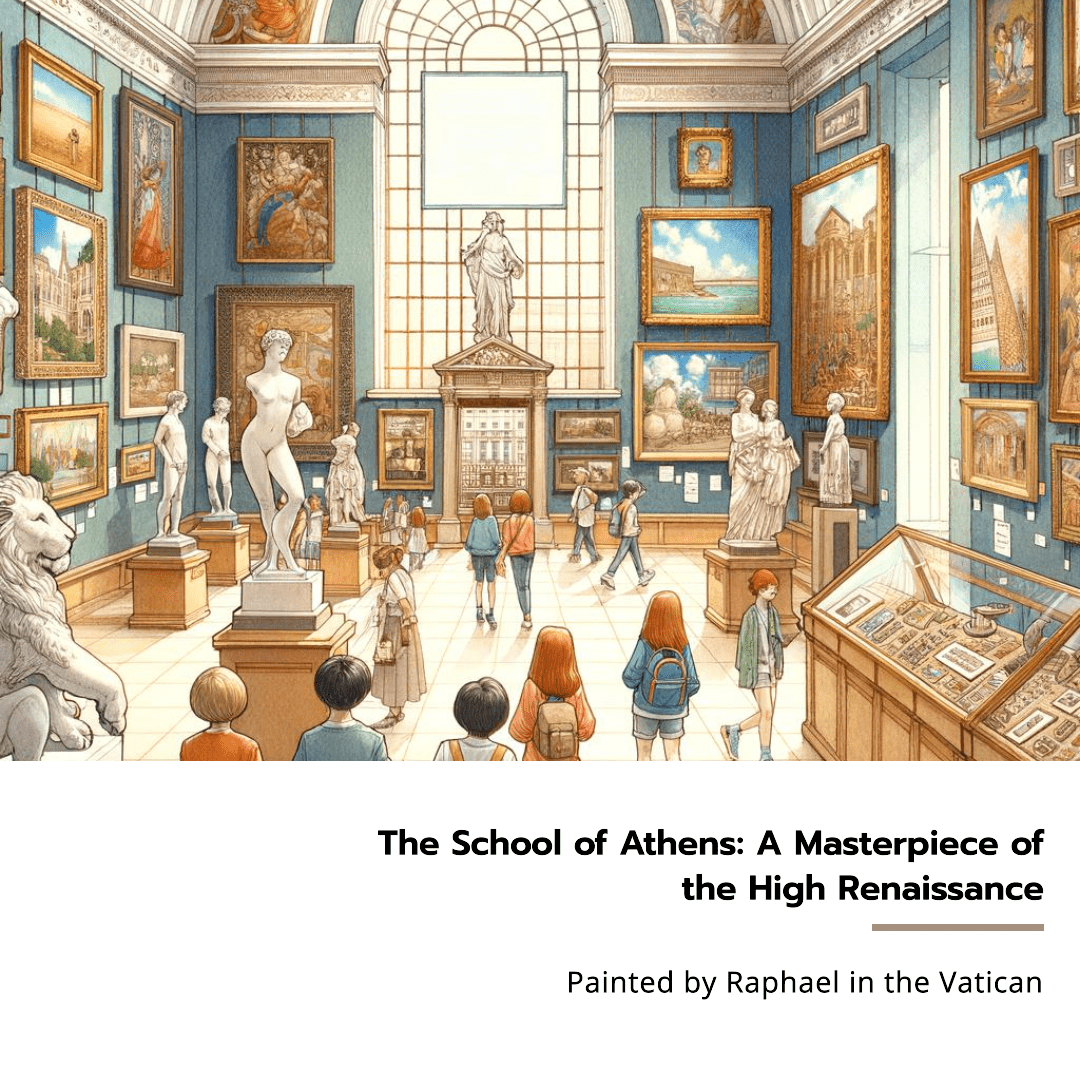
The School of Athens, painted by the illustrious Renaissance artist Raphael between 1509 and 1511, stands as one of the most significant frescoes of the High Renaissance period. Housed in the Apostolic Palace in the Vatican, this masterpiece is part of Raphael’s commission to decorate the rooms now known as the Raphael Rooms. It is celebrated not only for its aesthetic beauty and technical mastery but also for the profound philosophical narrative it encapsulates. The painting represents a world of intellectual exchange and symbolizes the heights of human thought achieved through the Renaissance’s revival of classical wisdom.
The Genesis of a Masterwork
Commissioned by Pope Julius II, Raphael’s task was to embody the spirit of the Renaissance, an era that saw a rebirth of interest in the art, literature, and philosophy of ancient Greece and Rome. The School of Athens is a testament to this era, capturing the essence of classical philosophy through its representation of ancient philosophers engaging in dialogue, teaching, and debate.
School of Athens – An Assembly of Great Minds
At the heart of the fresco is a gathering of the most influential philosophers and scientists of the ancient world, depicted in a grand architectural setting reminiscent of ancient Roman structures. Plato and Aristotle, the central figures, stand in the middle of the composition, embodying the philosophical duality of idealism versus empirical observation. Surrounding them is a throng of other seminal thinkers, each engaged in activities that reflect their contributions to philosophy, mathematics, and science.
Plato, pointing upwards, holds his “Timaeus,” signifying his belief in transcendent forms and ideals. Aristotle, his hand extended outward, clutches his “Ethics,” symbolizing his focus on earthly matters and empirical observation. These gestures not only highlight their philosophical differences but also invite viewers to engage with the fundamental questions about existence and knowledge.
Symbolism and Composition
Raphael’s use of space and perspective in The School of Athens is masterful, drawing the viewer’s eye towards the central figures of Plato and Aristotle. The architectural elements, with their precise symmetry and balance, evoke a sense of harmony and order, mirroring the intellectual clarity and rigor that the painting celebrates.
Each figure in the fresco is carefully chosen and placed to symbolize different facets of human knowledge. For example, Pythagoras is depicted with a book and students, reflecting his contributions to mathematics and music theory. Euclid, possibly modeled after Raphael’s contemporary Donato Bramante, is shown teaching geometry, emphasizing the Renaissance’s deep respect for scientific and mathematical principles.
A Mirror of the Renaissance Mind
The School of Athens is more than just a depiction of ancient philosophers. It is a mirror reflecting the Renaissance’s ideals of knowledge, beauty, and the pursuit of understanding. Raphael’s inclusion of contemporaries like Michelangelo, Leonardo da Vinci, and himself within the fresco bridges the gap between the ancient and modern worlds, asserting the continuity and relevance of classical wisdom.
Conclusion
Raphael’s The School of Athens is a profound celebration of the intellectual spirit of the Renaissance. It encapsulates the era’s reverence for the ancient past and its belief in the power of human reason and inquiry. Through its harmonious composition, the fresco invites viewers to contemplate the legacy of classical philosophy and its enduring influence on the world. As a masterpiece of Renaissance art, it continues to inspire admiration and reflection, serving as a testament to the enduring quest for knowledge and understanding that defines the human experience.
